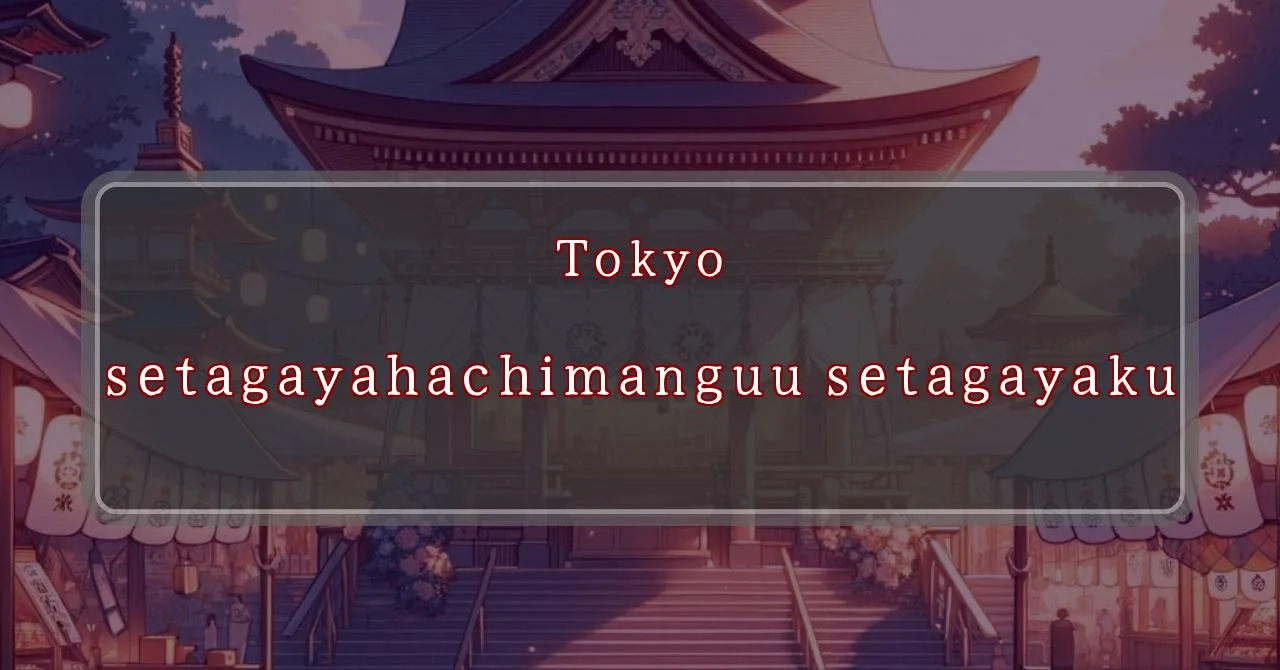Divine illumination at Setagaya Hachimangu Shrine
Basic Information
Setagaya Hachimangu Shrine is a Shinto shrine located in Setagaya Ward, Tokyo, Japan. It is dedicated to the three deities of Hachiman, the god of war and guardian of warriors, and is considered one of the most important Hachiman shrines in the Kanto region.
- Address: 1-26-3 Miyasaka, Setagaya-ku, Tokyo 156-0051
- Phone Number: 03-3429-1732
- Access: 1-minute walk from Miyanosaka Station on the Tokyu Setagaya Line, or a 12-minute walk from豪徳寺 Station on the Odakyu Odawara Line.
- Festival Days: September 15th and 16th, 2024
Main Events and Attractions of the Festival
The Setagaya Hachimangu Shrine Festival is a two-day annual event that takes place on September 15th and 16th. The festival features a variety of traditional Japanese cultural performances and activities, as well as food and games. Some of the main events and attractions of the festival include:
Mikoshi Procession
One of the highlights of the festival is the mikoshi procession, which takes place on both days of the festival. During the procession, portable shrines (mikoshi) are carried through the streets of Setagaya by teams of people. The mikoshi are believed to be inhabited by the spirits of the shrine’s deities, and the procession is a way to show respect to the deities and to pray for good fortune.
Kagura Performance
Kagura is a traditional Japanese Shinto dance and music performance that is often performed at festivals and other special occasions. At the Setagaya Hachimangu Shrine Festival, kagura performances are held on both days of the festival. The performances are typically performed by young women dressed in colorful costumes, and they tell stories from Japanese mythology and folklore.
Sumo Wrestling
Sumo wrestling is a traditional Japanese sport that is also featured at the Setagaya Hachimangu Shrine Festival. On both days of the festival, there are sumo wrestling matches held in the shrine’s sumo ring. The matches are open to all ages and skill levels, and they are a great way to experience this unique Japanese sport.
Food and Games
In addition to the cultural performances and activities, the Setagaya Hachimangu Shrine Festival also features a variety of food and games. There are food stalls selling a variety of Japanese dishes, as well as games and activities for children and adults alike. The festival is a great place to enjoy a day out with family and friends, and to experience traditional Japanese culture.
Blessings and Deities
Setagaya Hachimangu Shrine is dedicated to the three deities of Hachiman, the god of war and guardian of warriors. Hachiman is also revered as the protector of the imperial family and the nation of Japan. The shrine is believed to have been founded in 1091 by Minamoto no Yoshiie, a samurai warrior who was victorious in the Later Three-Years War. Yoshiie is said to have enshrined Hachiman at Setagaya after he prayed to the deity for victory in battle.
- Deities enshrined: Hachiman, the god of war and guardian of warriors
- Benefits of worship: Protection in battle, victory, success in martial arts, good luck in business, safe childbirth, and good health
Origin and History
The origins of Setagaya Hachimangu Shrine can be traced back to the Heian period (794-1185). In 1091, Minamoto no Yoshiie, a samurai warrior who was victorious in the Later Three-Years War, is said to have enshrined Hachiman at Setagaya after he prayed to the deity for victory in battle. The shrine was originally a small shrine, but it was expanded and renovated several times over the centuries. In 1546, the shrine was rebuilt by Yoshiie’s descendant, Yoshimasa. The current shrine buildings were constructed in 1961.
- Founded: 1091
- Founder: Minamoto no Yoshiie
- Rebuilt: 1546, 1961
Tips and Notes for Visitors
Here are some tips and notes for visitors to Setagaya Hachimangu Shrine:
- The shrine is open daily from 9:00 AM to 5:00 PM.
- Admission is free.
- The shrine is a popular destination for weddings and other ceremonies, so it is best to visit during the week if you want to avoid crowds.
- There is a small museum on the shrine grounds that displays artifacts related to the shrine’s history and traditions.
- The shrine is located a short walk from Miyanosaka Station on the Tokyu Setagaya Line.
Parking Information
There is no parking lot at Setagaya Hachimangu Shrine. However, there are several coin-operated parking lots in the area.
- Setagaya Public Parking Lot: 5-minute walk from the shrine
- Miyanosaka Station Parking Lot: 3-minute walk from the shrine
- Haudokuji Station Parking Lot: 10-minute walk from the shrine
Popular Stalls and Food Carts in Recent Years
| Type of Stall | Description |
|---|---|
| Takoyaki | A staple at Japanese festivals. Characterized by a crispy outside and a creamy inside. |
| Jaga Butter | A simple yet popular snack of hot potatoes lavishly topped with melted butter. |
| Baby Castella | Small castella cakes, sweet and fluffy treats enjoyed by children and adults alike. |
| Grilled Ayu with Salt | Fresh ayu fish grilled whole with salt, a savory taste of Japanese summer. |
| Shaapin | A unique gourmet item influenced by foreign cuisine, with a chewy skin wrapping the filling. |
| Okonomiyaki | A Japanese grilled dish where you often choose your own ingredients for a personalized flavor. |
| Cotton Candy | A fluffy, sweet snack that’s extremely popular with children. |
| Chocolate Banana | A banana coated in chocolate, a fun and visually appealing dessert. |
| Kushiyaki | Various types of ingredients skewered and grilled, an easy-to-enjoy snack. |
| Yakisoba | Fried noodles mixed with a special sauce, a fast food favorite in Japan. |



